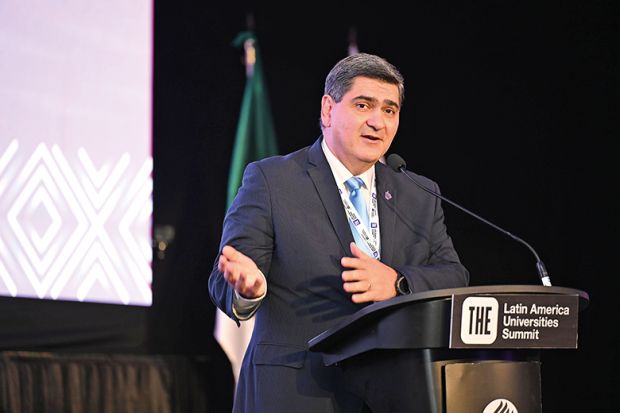Browse the full results of the World University Rankings 2024
In 2020, David Garza, president of the Monterrey Institute of Technology, laid out a strategic plan for the university, located in the north-east of Mexico. Written into this was the goal “to attract 100 high-impact professors with international leadership experience” by 2025. Three years later, the institution has achieved more than a quarter of this target, with 27 “faculty of excellence” joining as of July.
“This is a faculty development programme; it is not just a faculty hiring programme,” Garza tells Times Higher Education of the initiative, which he hopes will transform not only his institution, but Mexican higher education, placing it among international destinations for scholars.
Monterrey Institute of Technology, known informally as “Tec”, has 60,000 students spread across 26 campuses. The new faculty are primarily for the campuses in Monterrey, Mexico City, Guadalajara and Querétaro. The towering private institution also sponsors several high schools, which have a total of 30,000 students, with those taking advanced International Baccalaureate courses eligible to receive Tec credit for them. In 2002, the university created another smaller non-profit university called TecMilenio, where 80 per cent of students study on scholarships.
Garza, an alumnus of the institution who worked on faculty for 30 years before becoming rector in 2017, says that Tec was once in an expansion phase – but isn’t any longer. Now, having entered the “consolidation” phase, it is focusing on bringing in foreign faculty to improve the quality of education. Internationalisation, in this context, is being used as a tool on its home turf instead of abroad.
He admits that it was not easy to make the call to invest in hiring international scholars, considering the university already employs 2,000 local researchers. To attract “top-notch faculty” from overseas, Tec has to compete with a global standard of living; it has earmarked a budget of $60 million (£46 million) for this purpose.
“This implies that perhaps it is three or four times [the salaries that] we currently have here. But then our thinking was, well, we need to bring faculty that is three times or four times [the quality] we currently have, as an average,” he says.
But despite the bigger pay cheques, Garza is clear on the role of such researchers: “We are not bringing them [in] to be elites.”
He emphasises that the idea is to bring in specialists and leaders who can be “role models”, inspiring Tec’s faculty. Garza is keen for overseas recruits to bring in new schools of thought and act as “a catalyst for something that is evolving” – the institution, as it changes with the times. The university’s strategic plan also states that this talent drive is working to “continue the processes of attracting, developing and strengthening our faculty”.
For each academic hired, the university sets different development goals. These can include action-oriented aims, with some experts hired to work on big projects with industry, while in other instances they may work purely as basic researchers. There is no “one-size-fits-all” target, Garza says, but each new hire is expected to contribute to raising the “qualifications and the experience” of university faculty.
He hopes they will foster a better academic and research environment, which in turn will attract more international faculty and also convince them to stay.
Garza relays conversations with foreign academics and visitors who set foot on the campus. “Unfortunately, sometimes they say: ‘I didn’t expect to see this in Mexico,’” he says in reference to the facilities on campus. “I say ‘unfortunately’, because I think that we really have a country with lots of strengths and with lots of opportunities.”
Tec, along with other public and private institutions in the country, he says, is “committed to having a better Mexico from the Mexico that we have today”.
The pressing need to solve local problems is another driving factor behind bringing in foreign talent. For instance, the country is in critical need of research to prevent obesity as well as monitor it. According to the World Health Organization, obesity-related diseases, including cardiovascular diseases and diabetes, are Mexico’s leading causes of death. In 2016, the Mexican government declared obesity an epidemic.
Tec has been deeply involved in tackling public health issues, including through its university-run hospital, which was at the forefront of Mexico’s research into the coronavirus during the pandemic. Currently, a researcher from Sweden’s Karolinska Institute is at Tec running clinical trials on obesity; it is efforts such as this that benefit from international recruitment, Garza reiterates.
Already, the university has succeeded in drawing overseas faculty into fields such as engineering, nanotechnology, health sciences, business and marketing and architecture. New professors come from a diversity of institutions, with Babson College, the University of California, Irvine and The Hong Kong University of Science and Technology represented. Among the source countries for incoming talent, the US is “dominating”, with Latin America in the “minority”, Garza notes.
He hopes that bringing in globally renowned faculty will raise the quality of research, boosting his country’s reputation as a leader others can turn to in tackling big-picture issues.
“We also want to be a university that has more international visibility due to the contributions that we make for big, important problems,” he says, mentioning one big project under way: the university is creating the largest genetic biobank of the Hispanic population in the world, according to Garza.
The project aims to sequence 100,000 genomes, starting with Mexico. Like biobanks in the US and the UK, it has the potential to become “a platform for research”, not just for the university, but also for researchers and pharmaceutical companies across the world, he says.
A recent trip to the World Economic Forum has made Garza think more about what he can do to create links between countries such as Mexico and top research producers in the Global North and elsewhere. At the event, he was the only leader to attend from a Latin American university. Being able to be part of discussions on this scale, he says, gave him different ideas for how to engage with universities around the world.
The answer, he believes, is in “strong alliances, deep alliances” which are lasting.
“It’s not going to be a one-year initiative, it is not going to be some faculty initiative, but it is going to be an institutional initiative,” he says.
The priority is a current one, but Tec is no newcomer to overseas connections. During the Second World War, in 1943, Massachusetts Institute of Technology graduate Eugenio Garza Sada – no relation to its current head – founded the private institution.
“I think that something that is attracting this faculty is that we are a very innovative university, and we like to engage in very ambitious projects,” Garza reflects. Being a private university can sometimes mean that things move quicker too, he says. After all, it was only a few years ago that Tec overhauled its education model, focusing on an “engaging university experience”.
Its location has also been helpful. The city of Monterrey was historically an industrial city, abuzz with entrepreneurship. Still, crime had been rampant until recently, ebbing in the last decade when urban regeneration work – largely led by the university – took place, he says. “Tec District”, as the university vicinity is now known, is “10 times the size of the campus”. Soon the city will be the destination for Tesla’s largest assembly factory.
But Garza already has his eye on even bigger changes, still far on the horizon. He recently held a meeting on “Tec 100”, the university’s vision as it moves towards its centenary. As the university celebrates its 80th birthday, he and his team are shaping a vision for the era ahead.
Perhaps it is unsurprising that Garza appears restless, emphasising the need to steer clear of complacencia, Spanish for complacency.
“Something that always bothers me is this: is there something that I am missing? Is there an opportunity that I am not seeing or not catching?”
tiya.thomas@timeshighereducation.com
This is part of our “Talking leadership” series with the people running the world’s top universities about how they solve common strategic issues and implement change.Follow the series here.
Register to continue
Why register?
- Registration is free and only takes a moment
- Once registered, you can read 3 articles a month
- Sign up for our newsletter
Subscribe
Or subscribe for unlimited access to:
- Unlimited access to news, views, insights & reviews
- Digital editions
- Digital access to THE’s university and college rankings analysis
Already registered or a current subscriber? Login








